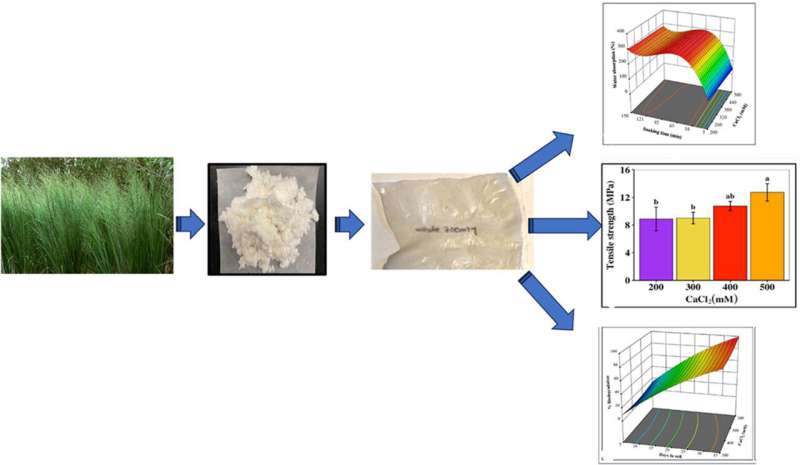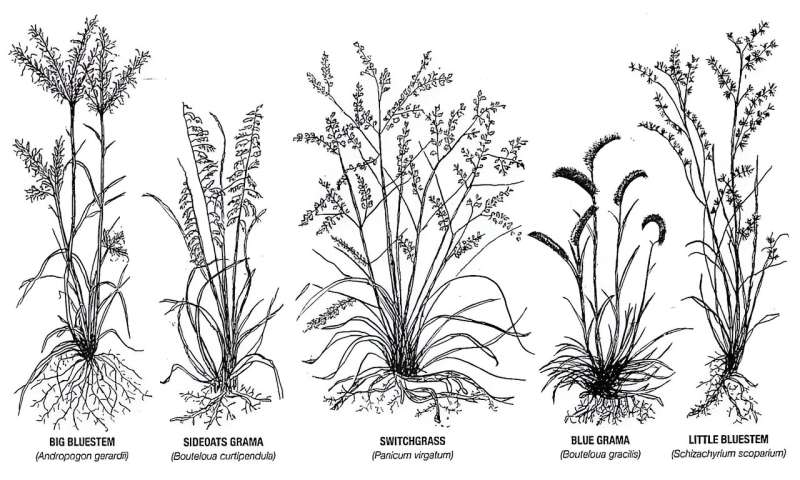This article has been reviewed according to Science X's editorial process and policies. Editors have highlighted the following attributes while ensuring the content's credibility:
fact-checked
trusted source
proofread
Researcher turns switchgrass into bioplastics

Plastic, made in the traditional petroleum-based method, has served its purpose. The near-perfect packaging material has been instrumental in transforming the world's food supply and can be found in nearly every sector of daily life.
But as humans have become increasingly reliant on plastic, serious environmental issues, like the Great Pacific Garbage Patch, have emerged. A natural, plastic-like alternative is sorely needed and, according to South Dakota State University researcher Srinivas Janaswamy, a sustainable remedy is within reach.
Bioplastics—plastic-like films that have the same qualities as petroleum-based plastic but are made from natural materials—are our best chance at chipping away at the ongoing plastic waste crisis, said Janaswamy, associate professor in SDSU's Department of Dairy and Food Science.
"Plastics are used for convenience in every household, but many are not appropriately recycled and are dumped everywhere around the globe," Janaswamy said. "Plastics take over 700 years to degrade and form an everlasting threat to our biosphere and ecosystem."
Janaswamy's research is on the leading edge of bioplastic development. Over the past few years, he has demonstrated how biodegradable films can be successfully created from a variety of agriculture byproducts, including avocado peels and spent coffee grounds.
A new study from Janaswamy's lab has demonstrated how a transparent and strong biodegradable film can be derived from switchgrass (Pancium virgatum), a perennial prairie tallgrass native to North America. The article, published in the journal Resources, Conservation and Recycling, is titled "Biodegradable films from the lignocellulosic residue of switchgrass."

In the United States, switchgrass grows abundantly and in a variety of different climates, making it a valuable resource for soil conservation, ornamental grass, heat production and biofuels. Switchgrass is also composed of roughly 58% lignocellulosic material, making it an ideal material for the development of plastic-replacing products.
To make the films, Janaswamy and his research team—which includes Sajal Bhattarai, an SDSU grad and a graduate research assistant at Purdue University—first extracted lignocellulosic material, the most abundant renewable biomass on Earth, from milled switchgrass. Lignocellulosic material, or plant dry matter, is composed of cellulose, hemicellulose and lignin.
After the material was extracted, a filtration, bleaching, washing and drying process resulted in a white residue that was then used to create the films. Once fully dried, the team assessed the film's qualities.
Results showed the films to be transparent, high in tensile strength and completely biodegradable within 40 days at 30% soil moisture. The last characteristic—biodegradation—is crucial in the development of bioplastics as the primary challenge with petroleum-based plastics is their inability to degrade. For example, a plastic bottle will take more than 700 years to naturally degrade in soil. Bioplastics, ideally, would biodegrade in a fraction of that time, greatly reducing the amount of plastic waste in the environment.
"This research successfully demonstrates biodegradable, biocompatible, strong and transparent films can be made from the lignocellulosic residue of switchgrass," Janaswamy said. "The film possesses high tensile strength, low water vapor permeability and good biodegradability."
The one downside of the films is relatively low elongation, especially in comparison to synthetic films. Janaswamy attributes this to the structural nature of the rigid lignocellulose network structure. Plasticizers, liquids added to plastics to soften them, generally improve film flexibility and elongation. However, plasticizers were not tested in this particular study. Janaswamy notes this will be an area of interest for future research.
Outside of eliminating plastic waste and subsequently helping the environment, this work could help farmers in the region generate extra income, as the materials utilized for bioplastics are often either underused or not used at all.
"Our planet needs sustainable, economical and environmentally friendly solutions to address the repercussions of plastics," Janaswamy said. "The strong and biodegradable switchgrass residue-based films open up a new window of opportunities to design and develop reusable, recyclable and compostable films from underutilized, inexpensive and abundant agricultural biomass, contributing to the circular rural economy in a friendly and sustainable manner."
More information: Sajal Bhattarai et al, Biodegradable films from the lignocellulosic residue of switchgrass, Resources, Conservation and Recycling (2023). DOI: 10.1016/j.resconrec.2023.107322
Provided by South Dakota State University




















